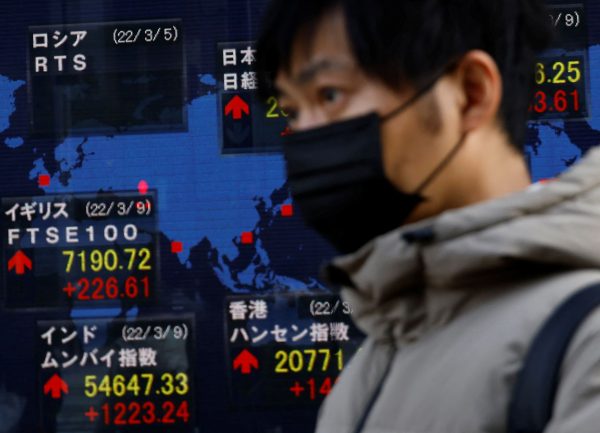Japanese sovereign debt relative to GDP has been the largest among G7 countries since 1998. It is double that of the United States (133 per cent) and far larger than second-place Italy (151 per cent). The Bank of Japan (BOJ) held 43 per cent of Japanese Government Bonds (JGBs) at the end of March 2022, raising concerns about just how affordable the national debt really is.
JGBs amounted to 71 per cent or 526 trillion yen (US$3.8 trillion) of the BOJ’s entire assets at the end of March 2022. The bank’s liabilities were 732 trillion yen (US$5.3 trillion), including 563 trillion yen (US$4.1 trillion) of current deposits — liabilities owed to depositors through financial intermediaries.
In 2012, some argued that the JGB rates could rise if the amount of debt outstripped the financial assets of the domestic private sector. They simulated the ceiling breach occurring within the next ten years. Based on the flow of funds at the end of 2021, the net financial assets of the non-financial private sector amounted to 188 per cent of GDP while general government liabilities reached 218 per cent of GDP.
The JGB landscape has changed dramatically, with the BOJ’s assets now four times larger than in 2012. This suggests that the simulation would have materialised in the absence of BOJ’s prolonged purchase of JGBs.
The current global monetary tightening environment has not changed BOJ’s easing stance. Japan’s low interest rates continue to diverge from rising levels in the United States, Europe and some emerging economies. The yen has fallen to a 24-year low, putting pressure on domestic prices already affected by global commodity price hikes.
Economics tells us that exchange rate management, monetary autonomy and free capital mobility are incompatible — ‘the impossible trinity’. Policymakers must give up one of these goals. Japan cannot maintain a stable yen, keep interest rates low and keep up free capital flows simultaneously. A rise in interest rates will soon become inevitable unless people tolerate price hikes or prefer capital control.
In April 2022, the International Monetary Fund (IMF) in its annual Article IV Consultation warned of the risks associated with a long-term rise in public debt. The IMF suggested that the current interest–growth differentials may not continue without the BOJ’s accommodative monetary policy and domestic investors’ home bias.
Academic discussions on the implications of an end to quantitative easing have long been muted. Political motives have weakened any sense of urgency and prolonged the affordability illusion. Policymakers seem to be buying time either for fiscal consolidation or for their much-anticipated economic revitalisation.
The Japanese government’s balance sheet shows a negative net worth of 592 trillion yen (US$4.3 trillion), with their authority to collect taxes existing conceptually as an invisible asset. The population’s ability to pay taxes depends on its wealth and income levels. Japan’s national wealth was 3,669 trillion yen (US$26.8 trillion) at the end of 2020 and nominal gross national income (GNI) was 563 trillion yen (US$4.1 trillion) in 2021.
Focusing on investment from savings may strengthen the nation’s assets quality and income generation capacity in the long term. But changes in the investment–savings balance may have a short-term impact on borrowers’ funding costs. Japan’s ageing demographic also depresses income growth and shrinks the tax base while spending on healthcare and pensions increases.
Tokyo is inclined to present optimistic growth prospects. In 2013, the ‘Japan Revitalization Strategy’ aimed for an average of 3 per cent nominal GDP growth over the next ten years in order to increase nominal GNI per capita by 1.5 million yen (US$10,949). Yet the nominal GNI peaked at 580 trillion yen (US$4.2 trillion) in 2019, a meagre rise from 526 trillion yen (US$3.8 trillion) in 2013.
On the other hand, general government gross debt has nearly doubled since 2000, when it sat at 136 per cent of GDP. Unaccomplished economic revitalisation aspirations have trapped policymakers in a time-buying mode full of repetitive rhetoric. Political compromise removed the deadline for the primary balance goal outlined in the ‘Basic Policy’ — the annual fiscal and economic policy guidelines released on 7 June 2022. Politically driven narratives of extravagant spending dominated debates during the Upper House election campaign.
Japanese Prime Minister Fumio Kishida’s initiative to reform the Japanese economy through a ‘new form of capitalism’ is another revitalisation trial. But peer pressure toned down his redistribution policy and investor backlash shelved the capital gains tax debate.
The domestic and international environments are now significantly less favourable than ten years ago, when limits for JGBs were suggested. Japan’s efforts to ‘defy gravity’ are already transitioning to a sharp descent.
Meanwhile, Kishida said on 27 May 2022 that his government continues to debate the capital gains tax. He also stated on 19 June 2022 that ‘we need to continue raising the banner of fiscal reconstruction’.
The landslide Upper House victory seems to have given the Prime Minister the political capital necessary for a ‘golden three years’ to revive the Japanese economy. But it will all be an illusion without a serious discussion on debt affordability and a resolute goal for fiscal health.
Toshiro Nishizawa is Professor at the Graduate School of Public Policy, the University of Tokyo.

